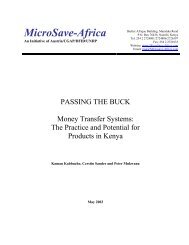You also want an ePaper? Increase the reach of your titles
YUMPU automatically turns print PDFs into web optimized ePapers that Google loves.
find alternatives as long as the Government <strong>of</strong><br />
Bolivia had the will to protect the people from<br />
intimidation.” CONCADE surpassed nearly all its<br />
targets, reaching more than 28,000 farm families<br />
and enabling those families to earn an average<br />
income <strong>of</strong> $2,275 per year, significant in that it<br />
exceeded the income earned from coca. Land<br />
devoted to licit crops increased to more than<br />
135,000 hectares, and the project directly created<br />
23,000 new on-farm and 58,000 <strong>of</strong>f-farm<br />
jobs.<br />
<strong>DAI</strong>’s water-related projects also became more<br />
complex and nuanced during the 1990s. The<br />
pioneering work in the field began, as it did in<br />
microenterprise, with a comprehensive desk<br />
study. Nearing the conclusion <strong>of</strong> a major USAID<br />
irrigation support project, the agency asked<br />
<strong>DAI</strong>’s Peter Reiss to produce a paper on collaborative<br />
planning and conflict resolution in<br />
water projects. Reiss sought the contributions<br />
<strong>of</strong> a pr<strong>of</strong>essional mediator and a well-known<br />
academic, and produced a study that laid the<br />
basis for USAID’s Fostering Resolution <strong>of</strong> Water<br />
Resources Disputes Project (FORWARD) in the<br />
Middle East. Beginning in 1996, the <strong>DAI</strong> team<br />
helped resolve water disputes in Egypt, Jordan,<br />
and Lebanon, and even consulted in the Middle<br />
East peace process. Pleased with FORWARD’s<br />
collaborative approach to problem-solving on<br />
notoriously contentious issues affecting water<br />
rights and uses, USAID eventually renewed the<br />
five-year contract for another five <strong>years</strong>.<br />
Public Opportunities,<br />
Commercial Setbacks<br />
Development pr<strong>of</strong>essionals had long understood<br />
that public sector performance—the effectiveness<br />
<strong>of</strong> the civil service and government<br />
institutions—could greatly help or hinder the<br />
development process. But not until the 1990s<br />
did <strong>DAI</strong> actively enter the domain <strong>of</strong> governance<br />
and public sector management. This was an<br />
area to which the Clinton administration and<br />
USAID’s leadership were devoting lots <strong>of</strong> attention,<br />
and political changes in Central Europe<br />
and Eurasia had boosted demand for qualified<br />
technical assistance in the field <strong>of</strong> governance.<br />
<strong>DAI</strong> established a foothold by winning an IQC<br />
for USAID’s Public Administration Assistance<br />
Program in Eastern Europe, and the award <strong>of</strong><br />
the large local government contract in Poland<br />
further raised its pr<strong>of</strong>ile.<br />
Leading this new push was Michael Morfit, who<br />
had helped move USAID into the democracy<br />
arena before joining <strong>DAI</strong> in 1996 to lead a new<br />
practice devoted to public sector management.<br />
His team helped strengthen local governments<br />
in Poland to rationalize fiscal transfers, promote<br />
cost-effective policies, and support infrastructure<br />
development. In Albania, Estonia, and<br />
Macedonia, <strong>DAI</strong> worked with citizen groups to<br />
strengthen public budgeting, improve public<br />
sector management, and stimulate economic<br />
development. These new projects engaged<br />
<strong>DAI</strong>, working with subcontractors including the<br />
59



